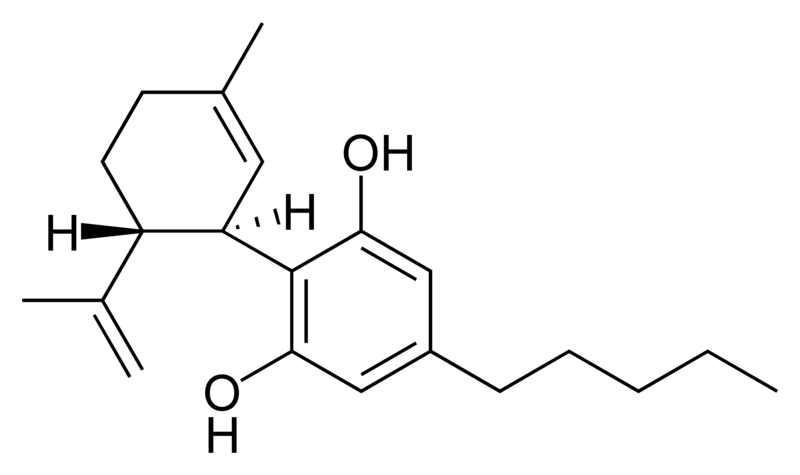Cannabidiol
 | |
| Clinical data | |
|---|---|
| ATC code | |
| Identifiers | |
| |
| CAS Number | |
| PubChem CID | |
| DrugBank | |
| E number | {{#property:P628}} |
| ECHA InfoCard | {{#property:P2566}}Lua error in Module:EditAtWikidata at line 36: attempt to index field 'wikibase' (a nil value). |
| Chemical and physical data | |
| Formula | C21H30O2 |
| Molar mass | 314.46 |
| 3D model (JSmol) | |
| Melting point | 66 °C (150.8 °F) |
| |
Overview
Cannabidiol, also known as CBD, is an antipsychotic cannabinoid found in the hemp plant Cannabis sativa. It is a major constituent of the plant, representing up to 40% in its extracts.[1]
CBD alone is not intoxicating, but it appears to affect the euphoric effect of THC (which is an isomer of cannabidiol) and add a sedative quality[citation needed]. Some research, however, indicates that CBD can increase alertness.[2] It may decrease the rate of THC clearance from the body, perhaps by interfering with the metabolism of THC in the liver. CBD does not appear to affect either the CB1 or CB2 receptors.[3]
Medically, it appears to relieve convulsion, inflammation, anxiety, and nausea, as well as inhibit cancer cell growth[citation needed]. Recent studies have shown cannabidiol to be as effective as atypical antipsychotics in treating schizophrenia.[4]
Medicinal use
In April 2005, Canadian authorities approved the marketing of Sativex, a mouth spray for multiple sclerosis to alleviate pain. Sativex contains tetrahydrocannabinol together with cannabidiol. It is marketed in Canada by GW Pharmaceuticals.
Cannabidiol has also been shown to inhibit cancer cell growth, with low potency in non-cancer cells. Although the inhibitory mechanism is not yet fully understood, Ligresti et al suggest that "cannabidiol exerts its effects on these cells through a combination of mechanisms that include either direct or indirect activation of CB2 and TRPV1 receptors, and induction of oxidative stress, all contributing to induce apoptosis."[5]
References
- ↑ Grlie, L (1976). "A comparative study on some chemical and biological characteristics of various samples of cannabis resin". Bulletin on Narcotics. 14: 37–46.
- ↑ Nicholson, AN (2004). "Effect of Delta-9-tetrahydrocannabinol and cannabidiol on nocturnal sleep and early-morning behavior in young adults" (fee required). J Clin Psychopharmacol. 24 (3): 305–13. ISSN 0271-0749. PMID 15118485. Retrieved 2007-05-03. Unknown parameter
|month=ignored (help); Unknown parameter|coauthors=ignored (help) - ↑ Straus, Stephen E. (15 August 2000). "Immunoactive cannabinoids: Therapeutic prospects for marijuana constituents". Proc Natl Acad Sci U S A. 97 (17): 9363–9364.
- ↑ Zuardi, A.W (2006). "Cannabidiol as an antipsychotic drug" (PDF). Brazilian Journal of Medical and Biological Research. 39: 421–429. ISSN 0100-879X ISSN 0100-879X Check
|issn=value (help). Unknown parameter|coauthors=ignored (help) - ↑ Ligresti, Alessia (2006-05-25). "Anti-tumor activity of plant cannabinoids with emphasis on the effect of cannabidiol on human breast carcinoma". Journal of Pharmacology and Experimental Therapeutics. American Society of Pharmacology and Experimental Therapeutics. Fast Forward (May 2006): 50. doi:10.1124 Check
|doi=value (help). jpet.106.105247. Retrieved 2007-05-03. Unknown parameter|coauthors=ignored (help); line feed character in|title=at position 47 (help)
See also
- Cannabinoids
- Cannabinoid receptors
- Cannabis
- Health issues and the effects of cannabis
- Medical marijuana
External links
- Erowid Compounds found in Cannabis sativa
de:Cannabidiol it:Cannabidiolo fi:Kannabidioli sv:Cannabidiol
- Pages with script errors
- Pages with citations using unsupported parameters
- CS1 errors: ISSN
- CS1 errors: invisible characters
- CS1 errors: DOI
- E number from Wikidata
- ECHA InfoCard ID from Wikidata
- Chemical articles with unknown parameter in Infobox drug
- Articles without EBI source
- Chemical pages without ChemSpiderID
- Articles without KEGG source
- Articles without InChI source
- Articles without UNII source
- Drugs with no legal status
- Articles containing unverified chemical infoboxes
- All articles with unsourced statements
- Articles with unsourced statements from July 2007
- Articles with invalid date parameter in template
- Articles with unsourced statements from September 2007
- Cannabinoids
- Antipsychotics
- Anti-inflammatory agents